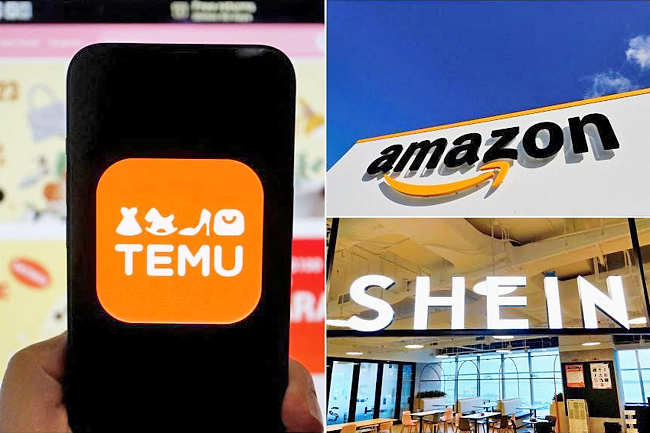CNA – Experts said that Chinese firms Shein, Temu, and TikTok Shop use algorithms to rapidly expand their brands without relying on traditional manufacturers, potentially creating long-term challenges for Amazon.
If Amazon is worried about competition from China, it only has itself to blame.
In 2013, Amazon introduced its third-party marketplace platform to Chinese manufacturers. Unwittingly, it showed them what it takes to challenge Amazon itself.
As China’s economy grew after its opening in the late 1970s, so did its production capacity.
But the United States (US) saw no threat because there were periodic episodes of concern for the safety of Chinese-made products.
Headlines would remind US consumers that Chinese products might contain dangerous levels of harmful substances.
China’s manufacturing output needed the endorsement of globally recognised brand names.
As e-commerce grew, consumer reviews became more important than brands.
The US remained confident that only US platforms could testify to quality and safety.
But Chinese businesses built their own platforms and used old-school advertising to pledge quality.
Using this combination of the platform marketing they had learned from Amazon and heavy spending on advertising that spoke to confidence in their products, they could approach Western markets without paying Amazon’s toll.

THE RISING THREE
The first Chinese platform to test this idea was Shein, which emerged in 2019 and has since become one of the largest online fashion companies in the world. It outsells H&M and Zara combined and does so with minimal reliance on retail stores.
Shein’s platform has two faces. One face looks towards consumers in the world beyond China, using deep skill in digital marketing to place tempting fast fashion items in front of target customers on social media sites, through its own website and on mobile apps. It also uses email, influencer and broadcast marketing to reach consumers beyond China.
The other face of the platform links a network of 6,000 clothing factories in China to demand throughout the rest of the world.
Shein is distinct in its remarkable sensitivity to the fashion tastes of its consumers.
It monitors what trendsetters wear on social media and when it sees a design that has potential, it commissions a very small order from one of its factories to see if consumers are interested. If they are, Shein re-orders.
Between July and December 2021, Shein used this sensitivity to tastes to induce its network of factories to add 2000 to 10,000 stock-keeping units per day to its app. Only through this tight integration can it persuade its factories to work exclusively with Shein rather than leak designs to competing platforms.
Next came Temu. It is a subsidiary of PDD Holdings, a multinational commerce group with extensive experience managing supply chains. Another of PDD Holdings’ subsidiaries, Pinduoduo, began as a platform to sell fresh produce and broadened to other manufactured products.
While Pinduoduo operates in China, Temu launched in the US in September 2022 and in Europe in April 2023.
Temu uses software to match China’s manufacturing capacity to demand in the US and increasingly the rest of the world, in more than 250 product categories.
Where Shein has 6,000 tightly integrated producers, Temu has more than 100,000, offering a much wider range of goods at startlingly low prices.
An electric cooking pot sells for USD2.14 and a swimsuit for USD6.18, with free shipping.
Temu attributes these prices to direct shipping from factory in China to consumer in the US, bypassing wholesalers and retailers.
Another new platform from China is TikTok Shop.
Building on the largest audience in the world for short-form media, TikTok Shop uses what it knows about its viewers’ tastes to help Chinese manufacturers find worldwide markets.
China used to lag behind Japan and South Korea in consumer brand building. Many thought that China might lack the sensitivity to Western cultural nuance that Japan and South Korea had mastered.
It turns out that algorithms, running on platform technology, can do the job. China is building household names in retail and media at a bewildering speed.
NOT A THREAT TO AMAZON – FOR NOW
How threatened is Amazon? Today, not too much. Although Amazon does not report the gross value of its retail sales, industry analysts estimate it at between USD700 billion to USD750 billion.
Though financial disclosures by all three Chinese companies are limited, it is unlikely that their combined global merchandise value is much beyond 12 per cent of Amazon’s. Temu’s gross merchandise value (GMV) is not officially disclosed, but it is estimated at USD15 billion by extrapolation from a Statista plot of recent growth.
Shein has projected its GMV to be USD60 billion in 2025. TikTok Shop forecasts its 2024 GMV to be USD17.5 billion. While these estimates are likely exaggerated, even so they amount to barely 12 per cent of Amazon’s GMV.
The longer-term challenge can be viewed through the paradigm of disruptive technologies, which proposes that an inferior entrant into a market may at first find a niche among buyers unwilling to buy the dominant option, but over time may invest to the point where it is preferred to the dominant option.
Shein and Temu often take two weeks to fulfil an order but their lower prices compensate for the longer wait. If Shein, Temu and TikTok Shop can grow their businesses, they can introduce new supply chain efficiencies, such as local warehousing. Shein is already offering its design and marketing services to suppliers beyond China.
Amazon is not ignoring the three Chinese platforms. In June 2024, Amazon reportedly told Chinese manufacturers that it would create a storefront on Amazon Marketplace on which they can sell and ship directly to US consumers, with orders fulfilled in nine to 11 days.
This is in marked contrast to Amazon’s prevailing emphasis on speed of order fulfilment – it can get an order to a buyer in under a day.
Amazon recognises that it is no longer the only game in town. And soon, if the innovators can build on their early success, it may no longer be the best.



















































